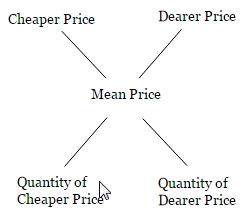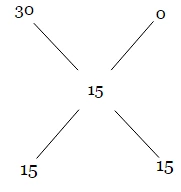What is alligation.
Alligation and Different Other Methods Involved
In this article, we are going to delve into the important concept of alligation, the rules of mixtures and alligation, and also about the methods involved in the concept of alligation. Speaking in terms of Science, the concept of alligation is a very important area, particularly in the quantitative aptitude for various competitive exams. Such an important concept called the rule of alligation will enable us in deriving the ratio under which there will be two or more than two ingredients for any given price that must be fixed to produce a mixture for the desired price. This technique can be applied for any relevant topic such as profit and loss, time and distance, percentage, simple interest and such other.
Alligation Meaning
In alligation and also in the rules of alligation, we perform studying of mixtures of two or more than two quantities that will be having various selling process and/ or the cost prices. Assume that you consider mixing a cheap substance with a costly substance. Now in such a situation, derive the value of the mixture that will be the result of it. It is that process that we study in the process of alligation and in the rule of alligation. In the below section, we will know about in detail the meaning of alligation, also about the mean price and also about the rules involved for alligation process. After observing the alligation and the rule of alligation, we will be going through some of the questions that are related to the alligation and also about the rules of alligation.
Alligation Rule
Before understanding of the formula of alligation and the rule of alligation, we will go through the concept of weighted average. For instance, let us assume that we are going to purchase 50 packs of chips at 10 rupees for each pack, and 30 packs separately at 20 rupees each. Then determine the average cost for this given particulars. And also derive whether the average will be finding out by the 20 rupees packs or the 10 rupees packs, in such particular fields that we are going to need the concept of weighted average.
The rule that enables us to derive the ratio, for which the two or more ingredients must be mixed in order for producing a mixture at the desired price, is referred to as alligation.
Alligation method
Even though many aspirants of the field are found using this particular method in a different format, which is called a criss-cross method, this method is very popular in the field of Science. Below is the format for the given criss-cross method:

In this method, the working process will include the positive difference of the cheaper price and mean price and then list out the difference in the place of quantity of dearer price. In the similar manner, we take the positive difference of dearer price and mean price and then list out the difference in the place of quantity of cheaper price.
For the above example problem, the working method of the criss-cross method will be as follows:

By observing the above derivation, it can be noticed that the ratio for the quantity between the cheaper price to the quantity of dearer price will 10:5 = 2:1.
It is important to note that the order under which the cheaper price and the dearer price for the above method will be following the order under which they are shown in the question.
Rule of Constant
There are some other types of questions related to mixtures and alligation wherein the quantity of one element in the mixture will not change even though when adding another element to the first mixture. For all such questions, it is recommended to follow another alternate method for using the rule of constant to derive at the answer. This alternate concept will be using the simple comprehension of the percentages. It is easy to understand this alternate concept with an example.
Problem: In order to make a mixture of 15% milk solution, find out the number of litres of pure water that should be added to 40 litres of 30% milk solution?
Method I: This method involves following a simple and standard textbook approach.
Let us first assume that the quantity of water to be added as x litres. It is given that the quantity of milk present in the existing solution as 30% of 40 = 12 litres. Now, with the addition of the water to this given existing solution, the quantity of the new solution will be (40 + x) litres. It is required based on the question that the new solution should be 15% of milk solution. Hence,
1240+x×100=151240+x×100=15
Thus, solving the above equation for x, we arrive at the value of x as 40 liters.
Method II: Another method is the rule of alligation, which we are discussing about in this article.
Let us consider the milk as a common element in both the solutions and there is 30% milk in the first solution and there us 0% milk in the second solution, which means it is pure water without any presence of milk.
Now, by mixing them, we get the desired solution of 15% milk in the final solution. Hence,

Or, in the other view, the ratio of the quantity between the first and the second solution should be 15:15 = 1:1
Thus, based on the necessary observations of the derivations, it can be found that a total of 40 liters of pure water should be added to the mixture to get the required new 15% of milk solution.
Related Videos:
- What is mean price
- Quantity of pure liquid in final mixture when y units are taken out and replaced by water
- Rule for solving alligation problem
- Miscellaneous
Conclusion
Thus, after necessary explanation of the alligation concept, methods involved other than alligation, and the rules of alligation, we have properly understood that rule of alligation is referred to as the process of determining the ratio of the quantities being inversely proportional with the differences in their cost from the mean value.
Important Chapters:


It is important to note that the order under which the cheaper price and the dearer price for the above method will be following the order under which they are shown in the question.

Similar Questions
Knowledge Check
What is taught is not what is learnt because
Aa teacher or learner can never fully master any disciplineBstudents pay attention during informal discussionCa teacher's socio-economic level may differ widely from the studentsDstudents possess different abilities, personalities and come from a variety of backgroundsWhat is taught is not what is learnt because
Aa techer or learner can never fully master any disciplineBstudet pay attention during informal discussionCa teacher's socio economic level may differ widely from the studentsDstudents posses different abilities, personalities and come from a variety of backgrounds.What is taught is not what is learnt because
AA teacher or learner can never fully master any disciplineBStudents pay attention during rinformal discussionCA teacher's socioeconomic level may dif fer widely from the students'DStudents possess different' abilities, personalities and come from a variety of backgrounds
What is galvanization? What purpose is served by it?
View SolutionRule for solving alligation problem
View SolutionWhat is ligament ? What is its function?
View SolutionWhat is lanthanoid contraction? What is its cause and what ar its consequences ?
View SolutionWhat is taught is not what is learnt because
View Solution
